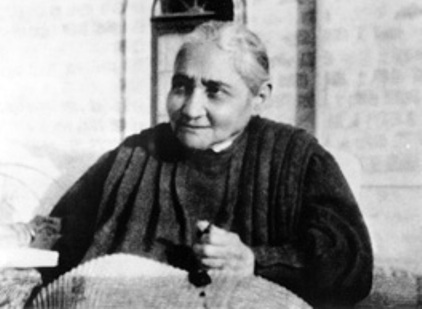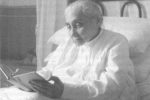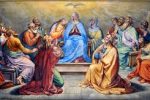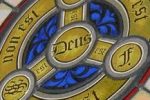Luisa Piccaretta and the Divine Will

I have recently been asked, and I often get asked, about Luisa Piccarreta and “the Kingdom of the Divine Will.” The Church has neither approved nor formally condemned these “private revelations,” the teachings contained therein, and the movement based on the teaching. All is under investigation by the Church. But to answer the question of what I think, I am going to post two articles my brother, Fr. Terry Staples, wrote concerning the topic some years ago.
In a nutshell, I will say I am very skeptical that this private revelation has heaven as its source. In fact, I believe it is a great and very dangerous deception. I will repeat what my brother makes clear in his articles: the Church has not spoken definitively on the matter, but there are, I believe (in agreement with my brother), serious problems with these “revelations.” Here is the first if the two articles written by my brother, Fr. Terry Staples:
Luisa Piccarreta’s
Kingdom of the Divine Will:
Divine Revelation or Deceptive Innovation?
What if someone told you they had a collection of writings from Jesus Himself which contained spiritual insights and prayers–never before revealed to anyone in the Church–which could show you how to achieve a greater union with God, a greater holiness, than ever before possible? . . . a holiness which would place you far, far, above all the Saints that have gone before us? Sounds great, right? Too good to be true? I’m afraid that’s right too.
Unfortunately, there is a new theology on the market which is making outrageous claims and many good Catholics are being deceived into believing a very dangerous delusion. This new theology is based on the writings of Luisa Piccarreta which, of course, she claims to have received directly from Jesus Himself. According to these writings, Luisa has ushered-in a new Era in the Church–a new dispensation has dawned. The long awaited “Kingdom of the Divine Will” has finally come from heaven to earth. Are you confused yet? I will try to explain.
What is the “Kingdom of the Divine Will”?
According to the alleged revelations of Luisa Piccarreta there are three great Eras in salvation history which correspond to, and follow from, three great “fiats.” The first great fiat is the creative fiat: God creates all things by His Word—His “fiat”; this initiates the “age of creation.” The second fiat was made by the Blessed Virgin Mary: “let it be done to me…”; this ushered in the “age of redemption.” Finally, after many years of struggle and turmoil in the Church, God has decided to complete the work of creation and redemption by inspiring the third fiat: Luisa Piccarreta said, “let it be done to me…”; and her fiat, which is on an equal par with the fiat of creation and the fiat of our Blessed Mother, has brought the Church to a new level of sanctity. We now enter the “Era of Sanctification.” With Luisa’s fiat, the Kingdom of the Divine Will has come to earth and is available to all who will say “yes” to the Divine Will. Eventually, this new gift to the Church, the gift of the Divine Will, will spread to all its members and all of creation will be restored to a manner of life on a par with the life of Adam and Eve before the Fall. This new Kingdom is referred to as the Kingdom of the Divine Will (KDW).
This talk about “three Eras,” three “fiats,” an “Age of Sanctification” and the advent of the “Kingdom of the Divine Will” should sound very strange to Catholic ears simply because it has never been taught by the Church; but, the question before us today is: could it possibly be true? After all, can’t God do whatever He wants? How can we judge such as claim? Before answering these questions, we will first consider this new theology more deeply.
What Does it Mean to “Live in the Kingdom of the Divine Will”?
According to Luisa’s revelations, to “live in the Divine Will” is to literally possess the Divine Will itself in such a way that your actions become purely divine. Before Luisa came along, all that could be achieved by the Saints was a “poor and lowly union with God.” They could, by grace, do God’s will, but they could not actually possess the Divine Will and have It act in their stead. This new way of possessing the Divine Will has been introduced to the Church by Jesus Himself through Luisa (although Adam, Eve, and our Blessed Mother had this gift prior to Luisa). Here is how Jesus allegedly explains this new way of acting to Luisa: “When a soul acts in my Will her humanity is, as it were, suspended. Then the Divine Life of my Love takes its place and acts; and, as it acts in a creature, my love finds itself unburdened of its desire for expression” (BH, p. 94).[1] Contrasting the “old way” of holiness–i.e. obedience to God’s will by grace–with the new way–i.e. possession of the Divine Will– Jesus allegedly tells Luisa, “. . . to live in My Will is to reign in It and with It, while to do My Will [the “old way”] is to be at My orders. …To live in My Will is to live with a single Will–God’s Will–a Will all Holy, all Pure, all Peace.”[2] Many more examples could be sighted from her writings, hopefully this is enough to convey just how radical her claims really are. This leads us to the next question.
How Does One Receive the Gift of the Divine Will?
To receive this sublime gift of the Divine Will you must do two things: (1) become familiar with Luisa’s writings, and (2) fervently ask for the gift. Since Jesus has allegedly deposited this new doctrine with Luisa, the only way to receive the understanding necessary to acquire the gift is to have recourse to Luisa’s writings. Jesus refers to her as the “second mother” to the Church, surpassed in sanctity only by the Blessed Virgin Mary. Our Lord allegedly says to Luisa,
Since my Mother [Mary] was entrusted to Me and, being a Priest to Her, I entrusted to Her as a sanctuary all the laws, precepts and doctrines that the Church needed to possess. And, faithful as She was and zealous for even one of my words so they would not be lost, She deposited them in my faithful disciple, John. And for that reason my Mother has supremacy over all the Church. In the same way I have done this with you [Luisa]. Being necessary to serve the Fiat Voluntas Tua to all the Church, I have entrusted you to one of my ministers so that you might deposit in him everything I reveal to you about my Will: The Goods that it contains and how the creature should enter into it and how the paternal kindness wants to open another era of grace, putting the goods he possesses in heaven in common with the creature and restoring to man his lost happiness. (p. 14, BH).
At this point, you may be thinking, “This sounds strange, but how do I know whether or not God has given the Church a second mother who has made a way for us to achieve a new level of sanctity? This brings us to the $10,000.00 question:
What’s Wrong with the KDW?
The doctrine associated with the KDW, as presented above, is very problematic to say the least. For the purposes of this article, I will focus on one major problem: it violates the Catholic notion of Divine Revelation. In the First Eucharistic Prayer of the Holy Mass, the Church proclaims a central teaching of the Catholic faith: “. . . we offer them [the gifts] for all who hold and teach the Catholic faith that comes to us from the Apostles.” The Second Vatican Council teaches us:
Everything we need for holiness and increase in faith has been handed on from the Apostles once and for all (cf. Jude 3). What was handed on by the apostles comprises everything that serves to make the People of God live their lives in holiness and increase their faith. In this way the Church, in her doctrine, life and worship, perpetuates and transmits to every generation all that she herself is, all that she believes. (DV #8).
Contrary to this teaching, Jesus allegedly revealed to Luisa that “everything that serves to make the People of God live their lives in holiness . . .” was not handed on from the Apostles. Rather, Jesus told her that God has waited for this time in history to reveal to the Church a new and better way of holiness unknown to the Apostles. These are allegedly Jesus’ words to Luisa,
“…it is certain that I have called you first over other souls. Because to no other souls, however much I have loved them, have I shown How to live in my Will, The effects, the marvels, the riches that the creature receives who acts in my supreme will. Search the lives of the Saints as much as you wish or in books of doctrine and you will not find the wonders of My Will working in the creature and the creature acting in my will. The most you will find will be resignation, abandonment, the union of wills, but the divine will working in the creature and the creature in my will, you will not find this in anyone. This signifies that the time had not arrived in which my kindness would call the creature to live in such a sublime state. Moreover, even the way I ask you to pray is not found in any other…” (BH, p. xix).
Clearly, we have a contradiction here, right? I think so, but for the KDW enthusiast, some possible objections remain unanswered. Further clarification is necessary.
What about Private Revelation?
If it is true that “everything we need for holiness and increase in faith has been handed on from the Apostles,” what about all the sacramentals and devotions in the Church which have been introduced after the Apostles? What about the Rosary, the Scapular, the Miraculous Medal, Louis DeMontfort’s consecration to Mary? Aren’t these things “needed for holiness and increase in faith”? In order to answer this objection and distinguish between these sacramentals and Luisa’s new doctrine, we must understand the role of private revelation in the Church. For this we look to our handy Catechism:
“Throughout the ages, there have been so‑called “private” revelations, some of which have been recognized by the authority of the Church. They do not belong, however, to the deposit of faith. It is not their role to improve or complete Christ’s definitive Revelation, but to help live more fully by it in a certain period of history….
“Christian faith cannot accept “revelations” that claim to surpass or correct the Revelation of which Christ is the fulfilment, as is the case in certain non‑Christian religions and also in certain recent sects which base themselves on such ‘revelations.’” (CCC #67).
Notice the role of private revelations: they help us to live more fully by the Revelation that we already have. They cannot “improve or complete” what comes to us from the Apostles. Thus, devotions, which are sometimes based upon private revelation, such as the Rosary, Scapular, etc…, do not, and cannot, add any new doctrine to the Church; they simply help us to express and live our faith in a certain period of history. Our Holy Father, John Paul II, emphasized this point while making a pilgrimage to Fatima. He said,
“The Church has always taught and continues to proclaim that God’s revelation was brought to completion in Jesus Christ, who is the fullness of that revelation, and that “no new public revelation is to be expected before the glorious manifestation of our Lord” (Dei Verbum, 4). The Church evaluates and judges private revelations by the criterion of conformity with that single public Revelation. If the Church has accepted the message of Fatima, it is above all because that message contains a truth and a call whose basic content is the truth and the call of the Gospel itself.”[3]
From what has been said, the following criteria for judging a private revelation can be given: the teaching given in any private revelation must be demonstrable from Scripture and Tradition apart from any reference to the private revelation itself. In other words, the deposit of faith, “everything we need for holiness and increase of faith,” must be able to stand on its own without any reference to private revelation.
Now, we are ready to apply this criteria to Luisa’s revelations. Luisa’s “revelations” claim to do much more than help us live by what we have received. She claims to have opened an entirely new “era of grace” which was previously unknown to the Church. According to her revelations, what we have received from the Apostles is not enough to complete our sanctification–her revelations are essential. Here are the alleged words of Jesus to Luisa:
“With three FIAT’s I will complete the work of sanctification in man. . . . The generations will not cease until my Will reigns on earth. My Redemptive FIAT [i.e. Mary’s] will interpose itself between the Creative FIAT and the Sanctifying FIAT [Luisa’s]. They will entwine, all three together, and bring to fulfillment the sanctification of man. The Third FIAT [i.e. Luisa’s] will give creatures such grace that they will return almost to their original state. Only when I have seen man as he emerged from Me, will my work be complete. Then will I enjoy perpetual repose in this, my last FIAT. Only the Life of my Will shall return man anew to his original state. Therefore, be attentive and together with Me, help Me accomplish the sanctification of creatures.” (P. 125, BH).
Clearly, her revelations claim to improve and complete the Revelation we have received from the Apostles. The promoters of the KDW, basing themselves on Luisa’s writings, unabashedly claim that without referring to her writings, and without her fiat, it is impossible for us to reach the fullness of sanctity that God desires for all Christians. This claim contradicts Catholic teaching.
At this point, I believe we’ve established that Luisa’s “revelations” claim to do more than a private revelation can do. But, another objection remains.
Development of Doctrine?
Some will argue that Luisa’s “new doctrine” is not new at all. They claim that while her doctrine has obviously never been taught by the Church, it has remained hidden in Sacred Scripture and thus it is actually a part of the Revelation which comes to us from the Apostles. The Church . . . well . . . the Church just never realized it was there until Luisa. In other words, her teachings are defended under the guise of a legitimate “development of doctrine.” To answer this objection, we must review the Catholic understanding of how doctrine can expand and develop over time.
There is a genuine development of doctrine within the Church which is described in the Second Vatican Council as follows: “The Tradition that comes from the apostles makes progress in the Church, with the help of the Holy Spirit. There is a growth in insight into the realities and words that are being passed on” (Dei Verbum, #8). The important characteristic of a true development is that it is gradual; i.e., it progresses and grows in the Church over time. Following the example of Jesus’ parable of the mustard seed (Mk 4:31), legitimate development can be compared to the growth of a plant. Over the years it gradually, almost unperceptively, expands and yet remains the same plant. Our Catechism characterizes the development of doctrine in this way:
“’The Christian economy, therefore, since it is the new and definitive Covenant, will never pass away; and no new public revelation is to be expected before the glorious manifestation of our Lord Jesus Christ.’ Yet even if Revelation is already complete, it has not been made completely explicit; it remains for Christian faith gradually to grasp its full significance over the course of the centuries.” (CCC #66).
Hopefully, we can distinguish at this point the difference between the development of doctrine and an innovation of doctrine (which cannot be accepted). Every legitimate development in the Church must be organically connected to the Tradition: it builds upon and deepens what is already present in the minds of the faithful. Luisa’s new doctrine is not, by her own admission, connected with the Tradition; it is foreign to the mind of the Church. Therefore, it does not qualify as a genuine development of doctrine.
Perhaps some examples will help clarify. Some have tried to compare Luisa’s new teachings to the doctrine of the Assumption of Mary which was not defined by the Church until 1950. “What about the Assumption of the Blessed Virgin Mary?” they ask, “how can we say that this doctrine comes to us from the Apostles?” We will let Pope Pius XII answer this question and explain the rationale for defining the Assumption as a legitimate development of doctrine:
“Since the universal Church, within which dwells the Spirit of Truth who infallibly directs it toward an ever more perfect knowledge of the revealed truths, has expressed its own belief many times over the course of the centuries, and since the bishops of the entire world are almost unanimously petitioning that the truth of the bodily Assumption of the Blessed Virgin Mary into heaven should be defined as a dogma of divine and Catholic faith‑this truth which is based on the Sacred Writings, which is thoroughly rooted in the minds of the faithful, which has been approved in ecclesiastical worship from the most remote times, which is completely in harmony with the other revealed truths, and which has been expounded and explained magnificently in the work, the science, and the wisdom of the theologians‑we believe that the moment appointed in the plan of divine providence for the solemn proclamation of this outstanding privilege of the Virgin Mary has already arrived.” (Munificentissimus Deus #41).
Notice the criterion the Holy Father specifies to demonstrate the authenticity of the doctrine: it is “based on the Sacred Writings”, it is “thoroughly rooted in the minds of the faithful,” it is “approved in ecclesiastical worship from the most remote times,” it is “completely in harmony with the other revealed truths,” etc…. These are the marks of a legitimate development of doctrine. The doctrine of the Assumption cannot be traced to any individual person. It was not conceived as a personal “revelation.” It is rooted in Scripture and Tradition and has been an approved doctrine from the earliest days of Christianity.
How does Luisa’s doctrine stand up against these criterion? Unfortunately, the doctrine of a new “Era of Sanctification” initiated by a third “fiat” which would be necessary to bring our sanctification and redemption to completion, is simply not found in the Tradition. It is by definition, and by Luisa’s own admission, a new doctrine never before revealed to the Church: it is completely outside the deposit of faith. It fails every test of being an authentic development . . . it is not Catholic teaching.
There is one last objection which I feel obliged to address since I have personally encountered this many times. Some will argue: “But, Adam, Eve and Mary received the gift of the Divine Will, this proves that it is not ‘new doctrine.’” Or, what amounts to the same argument: “But Luisa’s writings fulfill the Lord’s prayer, doesn’t this imply they are rooted in Scripture and Tradition?” Both these questions obviously employ circular reasoning: they beg the question. The question is, do her writings fulfill the Lord’s prayer? We cannot conclude that they do, simply because they say they do. That would be a circular argument. How, then, can we know? The answer is, we must interpret the Scriptures with the mind of the Church. The Second Vatican Council teaches: “But since sacred Scripture must be read and interpreted with its divine authorship in mind, no less attention must be devoted to the content and unity of the whole of Scripture, taking into account the Tradition of the entire Church and the analogy of faith, if we are to derive their true meaning from the sacred texts” (DV #12). This is a very important aspect of Catholic exegesis. We cannot base our interpretation of Scripture solely on private revelation (cf. 2 Pet 1:20). Practically every heresy, every Protestant sect, every false doctrine promoted under the name “Christian,” claims to be founded on Sacred Scripture. Whenever we wrest the Scriptures from Tradition we come away with an invalid interpretation. Luisa’s interpretation of the Lord’s prayer is completely novel by her own admission. Luisa claims that the words “thy will be done on earth as it is in heaven” actually refer to the coming of the “Era of Sanctification” in which those who follow her teachings are elevated above all the Saints that have gone before them. They will fulfill this prayer by literally possessing the Divine Will on earth, and with this new possession, accomplish God’s will on earth precisely as the Saints do in heaven. Throughout the history of the Church we have seen innumerable commentaries on the Lord’s Prayer. The Church, as our Mother and Teacher, has drawn from the treasures of her Tradition and offered rich instruction on the Lord’s Prayer, especially in the Catechism of the Council of Trent and the new Catechism of the Catholic Church. The Church has never understood the Lord’s Prayer to have the meaning being promoted today by the KDW movement. Luisa’s interpretation is based solely on private revelation, it has no connection with the Tradition of the Church and is foreign to the analogy of faith. The conclusion is obvious, Luisa’s writings do not fulfill the Lord’s Prayer according to Catholic exegesis.
Conclusion
Having carefully and diligently studied this article, you are now prepared to address that someone who might try to entice you into believing that you can be part of a “new kingdom,” based on a “new revelation,” which promises a new and improved version of holiness. The Church teaches that everything we need for holiness and increase in faith has been handed on from the Apostles “once and for all” (Jude 3). Private revelations cannot add to this deposit of faith. In summary, Luisa’s writings claim to complete and surpass the revelation we have received from the Apostles; this is simply impossible. God cannot contradict Himself. Luisa explicitly denies that her doctrine has developed from the Tradition; this means it is not Catholic teaching. If Luisa’s writings are true, we will have to amend the First Eucharistic Prayer: “. . . We offer [the gifts] for all who hold and teach the Catholic faith that comes to us from the Apostles . . . and Luisa.”
[1] Piccarreta, Luisa. When the Divine Will Reigns in Souls, Book of Heaven: A selection of Passages. The Luisa Piccarreta Center for the Divine Will. Jacksonville, FL. 1995. P. 86.
[2] Citation taken from a pamphlet: The Kingdom of the Divine will: An Introduction to the Fulfillment of the Lord’s Prayer. The Luisa Piccarreta Center for the Divine Will. p. 22.
[3] Pope John Paul II. Homily at Mass in Fatima May 13, 1982.



